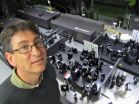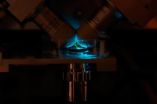(Press-News.org) Washington, D.C.—Meteorites hold a record of the chemicals that existed in the early Solar System and that may have been a crucial source of the organic compounds that gave rise to life on Earth. Since the 1960s, scientists have been trying to find proof that nucleobases, the building blocks of our genetic material, came to Earth on meteorites. New research, published next week in the Proceedings of the National Academy of Sciences, indicates that certain nucleobases do reach the Earth from extraterrestrial sources, by way of certain meteorites, and in greater diversity and quantity than previously thought.
Extensive research has shown that amino acids, which string together to form proteins, exist in space and have arrived on our planet piggybacked on a type of organic-rich meteorite called carbonaceous chondrites. But it has been difficult to similarly prove that the nucleobases found on meteorite samples are not due to contamination from sources on Earth.
The research team, which included Jim Cleaves of Carnegie's Geophysical Laboratory, used advanced spectroscopy techniques to purify and analyze samples from 11 different carbonaceous chondrites and one ureilite, a very rare type of meteorite with a different type of chemical composition. This was the first time all but two of these meteorites had been examined for nucleobases.
Two of the carbonaceous chondrites contained a diverse array of nucleobases and compounds that are structurally similar, so-called nucleobase analogs. Especially telling was the fact that three of these nucleobase analogs are very rare in terrestrial biology. What's more, significant concentrations of these nucleobases were not found in soil and ice samples from the areas near where the meteorites were collected.
"Finding nucleobase compounds not typically found in Earth's biochemistry strongly supports an extraterrestrial origin," Cleaves said.
The team tested their conclusion with experiments to reproduce nucleobases and analogs using chemical reactions of ammonia and cyanide, which are common in space. Their lab-synthesized nucleobases were very similar to those found in the carbonaceous chondrites, although the relative abundances were different. This could be due to chemical and thermal processing that the meteorite-origin nucleobases underwent while traveling through space.
These results have far-reaching implications. The earliest forms of life on Earth may have been assembled from materials delivered to Earth by meteorites.
"This shows us that meteorites may have been molecular tool kits, which provided the essential building blocks for life on Earth," Cleaves said.
###
Funding for various portions of this work was provided by the NASA Postdoctoral Program administered through Oak Ridge Associated Universities, the Goddard Center for Astrobiology, the NASA Astrobiology Institute, NASA Astrobiology: Exobiology and Evolutionary Program. Meteorites were provided by the NASA Johnson Space Center, the Smithsonian Museum of Natural History, P. Ehrenfreund, P. Jenniskens and M. Shaddad, the University of Melbourne Australia, and the 2006 ANSMET team.
The Carnegie Institution for Science (carnegiescience.edu) is a private, nonprofit organization headquartered in Washington, D.C., with six research departments throughout the U.S. Since its founding in 1902, the Carnegie Institution has been a pioneering force in basic scientific research. Carnegie scientists are leaders in plant biology, developmental biology, astronomy, materials science, global ecology, and Earth and planetary science.
Meteorites: Tool kits for creating life on Earth
2011-08-09
ELSE PRESS RELEASES FROM THIS DATE:
Biology, materials science get a boost from robust imaging tool
2011-08-09
EUGENE, Ore. -- (Aug. 8, 2011) -- Shape and alignment are everything. How nanometer-sized pieces fit together into a whole structure determines how well a living cell or an artificially fabricated device performs. A new method to help understand and predict such structure has arrived with the successful use a new imaging tool.
Coupling laser-driven, two-dimensional fluorescence imaging and high-performance computer modeling, a six-member team -- led by University of Oregon chemist Andrew H. Marcus and Harvard University chemist Alan Aspuru-Guzik -- solved the conformation ...
Guam researcher studies Mount Pinatubo ecosystem recovery
2011-08-09
University of Guam ecologist Thomas Marler recently mobilized efforts to characterize the vegetation that has recovered following the eruption of Mount Pinatubo, Philippines. "My interest was sparked by the paradox that this volcano's cataclysmic 1991 eruption was so powerful it changed global climate, yet after a full 15 years the biology of the recovering ecosystem had not been studied," said Marler.
The void of research motivated the Guam ecologist to spend a majority of 2006 conducting botanical surveys on the mountain. Marler then teamed up with University of Washington ...
Heavy metal -- in and around the lakes
2011-08-09
Heavy metal pollution of lakes has a seriously detrimental impact on people and ecosystems that rely on such bodies of water. According to a study published in the current issue of Interdisciplinary Environmental Review, researchers have focused on the physicochemical properties and toxicology of water from and around Thane City of Maharashtra.
Environmental chemist Pravin Singare of Bhavan's College, in Mumbai, and colleagues highlight the fact that fresh water bodies all over the world are becoming increasingly polluted day by day and that this represents a growing ...
Improved radical surgery techniques provide positive outcomes for bladder cancer patients
2011-08-09
Bladder cancer patients who have radical surgery at university hospitals can benefit from excellent local control of the disease, acceptable clinical outcomes and low death rates, according to research in the August issue of the urology journal BJUI.
Researchers studied 2,287 patients who had radical cystectomy surgery, where the bladder is removed, together with nearby tissue and organs as required. The surgery was performed at eight Canadian academic centres between 1998 and 2008.
The study found that there were three independent factors, apart from pathological ...
Live from the scene: Biochemistry in action
2011-08-09
Researchers can now watch molecules move in living cells, literally millisecond by millisecond, thanks to a new microscope developed by scientists at the European Molecular Biology Laboratory (EMBL) in Heidelberg, Germany. Published online today in Nature Biotechnology, the new technique provides insights into processes that were so far invisible.
By combining light-sheet microscopy and single molecule spectroscopy, the new microscope can record the fluorescence of every pixel within view, and take snapshots at intervals of less than one millisecond. With it, scientists ...
'Paranoia' about rivals alters insect mating behavior
2011-08-09
Scientists at the University of Liverpool have found that male fruitflies experience a type of 'paranoia' in the presence of another male, which doubles the length of time they mate with a female, despite the female of the species only ever mating with one male.
Females in many species of animal have multiple mates and males have evolved particular reproductive characteristics to ensure their sperm are successful when in competition with the sperm of other males. Adaptations include physical traits that result in increased sperm count, as well as behavioural alterations ...
Schoolchildren can also learn complex subject matters on their own
2011-08-09
Calculating the surface area of Gran Canaria is no easy task for a 14-year-old. It's not simply a question of learning the right formula. Students have to develop a strategy that enables them to put mathematical theory into practice – working out the information that is important and applying the right geometric models and tools. Realizing that the island has an almost circular shape and so its surface area can be approximated using the area of a circle is not as straightforward as it sounds. Are schoolchildren capable of developing these kinds of solutions themselves or ...
Light unlocks fragrance in laboratory
2011-08-09
In Anna Gudmundsdottir's laboratory at the University of Cincinnati, dedicated researchers endeavor to tame the extremely reactive chemicals known as radicals.
Highly reactive radicals are atoms, molecules or ions frantically trying to become something else. Their lifetimes are measured in fractions of seconds and typically occur in the middle of a chain of chemical reactions. They are also known as reactive intermediates. Much of Gudmundsdottir's work has focused on a family of radicals known as triplet nitrenes.
"Triplet nitrenes are reactive intermediates with high ...
Walking around is the simplest way to shorten hospital stay
2011-08-09
A new study from the University of Haifa has found that walking around the ward during hospitalization significantly reduces the length of the older patient's stay. "Given the over-occupancy of many hospitals, this finding can be of great importance," the researchers stated.
Walking around the ward during hospitalization reduces the length of geriatric patients' stay in internal wards. This has been shown in a new study by Dr. Efrat Shadmi and Dr. Anna Zisberg of the University of Haifa's Department of Nursing, funded by the Israeli Science Foundation and published in ...
Many top US scientists wish they had more children
2011-08-09
Nearly half of all women scientists and one-quarter of male scientists at the nation's top research universities said their career has kept them from having as many children as they had wanted, according to a new study by Rice University and Southern Methodist University (SMU).
The study, "Scientists Want More Children," was authored by sociologists Elaine Howard Ecklund of Rice and Anne Lincoln of SMU and appears in the current issue of the journal PLoS ONE.
For the past three years, Ecklund and Lincoln have been studying what junior and senior scientists in physics, ...


